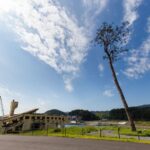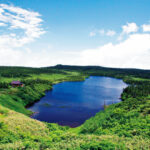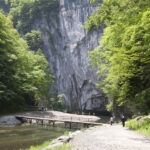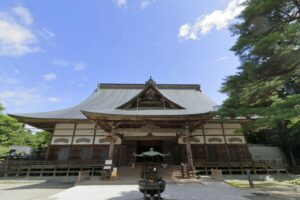
Nestled in the quiet hills of Hiraizumi, Iwate Prefecture, Chūson-ji Temple (中尊寺) is one of Japan’s most breathtaking spiritual and cultural treasures.
Famous for its Konjikidō (Golden Hall) — a stunning structure entirely covered in gold leaf — Chūson-ji represents the height of Buddhist art, architecture, and faith during Japan’s 12th century.
In 2011, Hiraizumi, including Chūson-ji, was recognized as a UNESCO World Heritage Site for embodying the ideals of the Buddhist Pure Land on Earth.
Contents
A Glimpse into History
Chūson-ji was founded in 850 CE by the revered Buddhist priest Ennin (Jikaku Daishi) of the Tendai sect.
However, the temple rose to prominence under Fujiwara no Kiyohira, the first ruler of the Northern Fujiwara clan, who rebuilt and expanded it in the early 12th century.
Kiyohira envisioned Hiraizumi as a peaceful Buddhist paradise, created after years of warfare in the Tōhoku region. He sought to express the Buddhist ideal of “Byōdō” — equality and harmony — through magnificent temples and artworks.
At its height, Chūson-ji consisted of over 40 halls and pagodas and 300 monk residences spread across the forested hill known as Kanzan (Mount Kanzan).
Today, only a fraction remains, yet what survives — especially the Konjikidō — continues to awe visitors from around the world.
Konjikidō: The Golden Hall
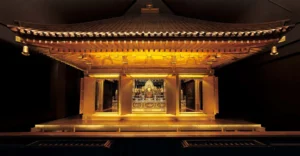
The heart of Chūson-ji is the Konjikidō (金色堂), completed in 1124.
It is a small but dazzling structure, entirely adorned in gold leaf, inlaid with mother-of-pearl, ivory, lacquer, silver, and precious gemstones.
Inside, the hall enshrines Amida Nyorai (the Buddha of Infinite Light) at the center, flanked by attendants Kannon Bosatsu and Seishi Bosatsu.
Beneath the altar rest the mummified remains of four generations of the Northern Fujiwara rulers, preserved in beautifully crafted lacquered coffins.
The Konjikidō stands as a symbol of both devotion and impermanence, its golden brilliance contrasting with the quiet greenery of the surrounding cedar forest.
To protect it from the elements, the hall is enclosed within a modern concrete structure known as the Konjikidō Oin (覆堂), which also houses interpretive displays and ambient lighting that highlight its timeless beauty.
Cultural and Artistic Significance
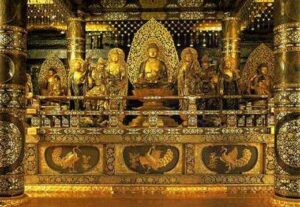
The artistry of Chūson-ji reflects the peak of Heian-period Buddhist culture as it spread from Kyoto to the distant north.
The combination of Tendai Buddhism and Pure Land imagery here represents the Fujiwara clan’s deep wish for peace and salvation.
Chūson-ji’s treasures include:
-
Over 3,000 National Treasures and Important Cultural Properties, including sutra scrolls, Buddhist statues, and decorative crafts.
-
The Chūson-ji Sutra, featuring hand-copied Buddhist scriptures written in gold and silver ink on indigo-dyed paper.
-
Exquisite raigō paintings, which depict Amida Buddha descending from heaven to guide souls to the Pure Land.
These treasures are preserved in the Sankōzō Museum, a modern facility on the temple grounds that displays rotating exhibitions of sacred artifacts.
Walking the Path of Tranquility

Visiting Chūson-ji is not just about seeing the Golden Hall — it’s about the journey up the hill through ancient cedar trees and stone paths that evoke centuries of devotion.
The main approach, called Tsukimizaka, begins near the Hiraizumi bus stop.
It’s a gentle 800-meter uphill walk, shaded by towering trees and dotted with sub-temples, statues, and stone pagodas.
Along the path, visitors can stop by:
-
Benkei-do (弁慶堂) – Dedicated to the legendary warrior monk Benkei, who served Minamoto no Yoshitsune.
-
Hondo (本堂) – The Main Hall, rebuilt in 1909, where daily prayers are held.
-
Bell Tower (鐘楼) – Its resonant sound echoes through the forest, marking the spiritual heart of the temple.
-
Sankōzō Museum (讃衡蔵) – Exhibiting many of the temple’s priceless cultural assets.
At the summit, the Konjikidō complex awaits, a fitting climax to this serene pilgrimage route.
Atmosphere and Experience
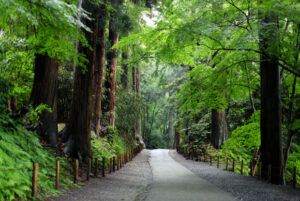
The moment you enter Chūson-ji, you’ll notice the silence and purity of the air. The smell of cedar, the soft rustling of leaves, and the faint ringing of the temple bell create a sacred calm that transcends time.
Unlike Kyoto’s bustling temples, Chūson-ji feels intimate and deeply spiritual — a place where nature, history, and faith coexist in perfect harmony.
Many travelers describe their visit as a journey through history, from the physical climb up the forest path to the emotional experience of standing before the golden Konjikidō.
Events and Festivals
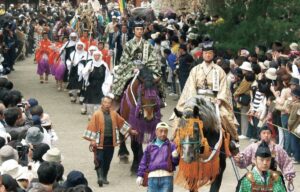
Chūson-ji hosts several traditional Buddhist and cultural events throughout the year:
-
Hatsumōde (New Year’s Visit) – January 1–3
Locals and travelers come to pray for good fortune at the start of the year. -
Spring and Autumn Fujiwara Festivals (藤原まつり) – May and November
Colorful processions featuring costumed participants reenact scenes from Hiraizumi’s glorious past. -
Bon Odori and Lantern Ceremonies – August
Nighttime events that illuminate the temple grounds in soft golden light, symbolizing peace for ancestral spirits.
These events offer a glimpse into local traditions that have continued for nearly a millennium.
Practical Information
Location:
Chūson-ji Temple (中尊寺)
Koromonoseki-cho, Hiraizumi-cho, Nishiiwai-gun, Iwate Prefecture, Japan
Opening Hours:
-
March–November: 8:30 AM – 5:00 PM
-
December–February: 8:30 AM – 4:30 PM
Admission:
-
Konjikidō & Museum: ¥800 (Adults), ¥200 (Children)
-
Temple grounds: Free
Access:
-
From Morioka: 40 minutes by JR Tohoku Shinkansen to Ichinoseki Station, then 10 minutes by JR Tohoku Line to Hiraizumi Station.
-
From Sendai: 90 minutes total by Shinkansen + local train.
-
From Hiraizumi Station: 20-minute walk or short taxi ride to the temple entrance.
Parking: Available near the lower gate for a small fee.
Facilities: Small teahouses, souvenir shops, and rest areas line the approach. Don’t miss the local Hiraizumi soba, made with buckwheat grown in the surrounding mountains.
Nearby Attractions
While visiting Chūson-ji, explore other World Heritage sites in Hiraizumi:
-
Mōtsū-ji Temple (毛越寺): Known for its elegant Pure Land garden and peaceful pond.
-
Takkoku no Iwaya Bishamon-dō (達谷窟毘沙門堂): A temple built into a cliffside cave.
-
Yanaginogosho Ruins: Archaeological remains of the Fujiwara residence.
-
Hiraizumi Cultural Heritage Center: A modern museum that contextualizes the area’s Buddhist history.
Together, these sites reveal the vision of a “Pure Land” utopia that once thrived here — a vision of peace that continues to inspire visitors today.
Final Thoughts
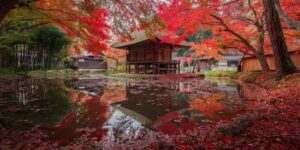
Chūson-ji is far more than a temple — it’s a living masterpiece of faith and art, radiating the light of Japan’s ancient Buddhist culture.
Standing before the Golden Hall, surrounded by the whispers of cedar trees, visitors can almost feel the prayers of the Fujiwara clan echoing through time.
Whether you’re a history lover, spiritual seeker, or curious traveler, Chūson-ji offers a rare opportunity to witness the timeless harmony between humanity, nature, and the divine — a golden paradise preserved in the heart of northern Japan.
Related articles
Official Website
https://www.chusonji.or.jp/language_en/index.html
Accommodation sites
Agoda
